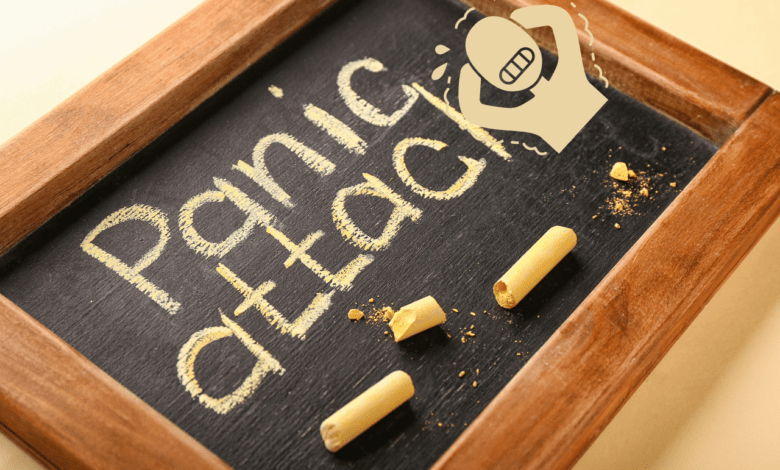Understanding Panic Attacks: Causes, Conditions, and Coping Strategies

Panic attacks are intense episodes of fear or anxiety that can strike without warning, leaving individuals feeling overwhelmed and out of control. These attacks are characterized by a sudden onset of physical and psychological symptoms that can be both distressing and debilitating. Common physical symptoms may include heart palpitations, shortness of breath, sweating, trembling, and chest pain. Psychological symptoms often involve a sense of impending doom, fear of losing control, or a feeling of detachment from reality.
During a panic attack, the body’s fight-or-flight response is triggered, leading to a surge of adrenaline and other hormones. This physiological response can cause a variety of uncomfortable sensations, such as dizziness, nausea, and tingling or numbness in the extremities. Panic attacks can be incredibly frightening, especially for those who have never experienced them before, as the symptoms can mimic those of a heart attack or other serious medical condition.
It’s important to note that while panic attacks are intense and distressing, they are not inherently dangerous or life-threatening. However, the fear and anxiety associated with these episodes can significantly impact an individual’s quality of life and daily functioning. Recognizing the signs and symptoms is crucial for seeking appropriate support and developing effective coping strategies.
Differentiating panic attacks from other conditions: Panic attack or epilepsy? Autistic meltdown vs panic attack.
While panic attacks can be overwhelming, it’s essential to differentiate them from other conditions that may present with similar symptoms. One such condition is epilepsy, a neurological disorder characterized by recurrent seizures. During an epileptic seizure, individuals may experience loss of consciousness, muscle spasms, and involuntary movements, which can be mistaken for a panic attack.
However, there are key differences between the two conditions. Panic attacks typically do not involve loss of consciousness or involuntary movements, and the symptoms tend to subside within a relatively short period, usually lasting between 5 to 30 minutes. In contrast, epileptic seizures can vary in duration and may require medical intervention.
Another condition that can be confused with panic attacks is an autistic meltdown. Individuals on the autism spectrum may experience sensory overload or intense emotional responses, leading to behaviors that resemble a panic attack, such as crying, screaming, or self-injurious behaviors. However, autistic meltdowns are often triggered by specific environmental factors or sensory stimuli, whereas panic attacks can occur without an apparent trigger.
It’s crucial to seek professional guidance if you are unsure whether your symptoms are indicative of a panic attack or another condition. Proper diagnosis and understanding of the underlying cause can help ensure appropriate treatment and support.
Causes of panic attacks: Exploring the underlying factors that contribute to panic attacks.
Panic attacks can have various underlying causes, and understanding these factors can aid in developing effective coping strategies and seeking appropriate treatment. Some common causes include:
- Biological factors: Imbalances in brain chemicals, such as serotonin and gamma-aminobutyric acid (GABA), can contribute to the development . Additionally, genetic predisposition and certain medical conditions may increase the risk.
- Psychological factors: Traumatic life events, stress, anxiety disorders, and depression can all play a role in triggering panic attacks. Negative thought patterns and cognitive distortions can also exacerbate anxiety and increase the likelihood of panic attacks.
- Environmental factors: Certain situations or environments, such as crowded places, enclosed spaces, or stressful life events, can act as triggers for panic attacks in some individuals.
- Substance abuse: The use or withdrawal from certain substances, such as caffeine, alcohol, or recreational drugs, can increase the risk of experiencing panic attacks.
Understanding the underlying causes of your panic attacks can help you identify potential triggers and develop personalized coping strategies. It’s important to work closely with a mental health professional to develop a comprehensive treatment plan tailored to your specific needs.
Common triggers for panic attacks: Alcohol and panic attacks, can alcohol cause panic attacks?
While alcohol is often used as a coping mechanism for anxiety and stress, it can actually exacerbate panic attacks and related symptoms. Alcohol is a central nervous system depressant, which means it can initially provide a sense of relaxation and reduced anxiety. However, as the effects of alcohol wear off, it can trigger a rebound effect, leading to increased anxiety, irritability, and even panic episodes.
The relationship between alcohol and panic attacks is complex. In some cases, alcohol can directly contribute to the onset of panic episodes, particularly in individuals who are already predisposed to anxiety disorders. Alcohol can disrupt the balance of neurotransmitters in the brain, leading to increased levels of anxiety and heightened physiological responses.
Additionally,
Alcohol withdrawal can trigger panic attacks in individuals who have developed a physical dependence on the substance. As the body adjusts to the absence of alcohol, it can experience a range of withdrawal symptoms, including anxiety, tremors, and even seizures, which can precipitate panic episodes.
It’s important to note that while alcohol may provide temporary relief from anxiety, it is not a sustainable or effective coping mechanism for panic attacks. In fact, regular alcohol consumption can exacerbate anxiety and increase the likelihood of experiencing panic episodes in the long run.
If you struggle with panic attacks and alcohol use, it’s crucial to seek professional help to address both issues simultaneously. A comprehensive treatment plan that incorporates therapy, medication (if necessary), and lifestyle changes can help you manage panic episodes and develop healthier coping strategies.
Silent panic attacks: What are silent panic attacks and how do they manifest?
Silent panic attacks, also known as “smothered” or “masked” panic attacks, are a type of panic attack that occurs without the typical physical symptoms associated with traditional panic attacks. During a silent panic attack, individuals may experience intense psychological distress, such as feelings of impending doom, detachment from reality, or a sense of unreality, without the accompanying physical symptoms like rapid heartbeat, shortness of breath, or sweating.
Silent panic attacks can be particularly challenging to recognize and manage because the lack of physical symptoms can make it difficult to identify the episode as a panic attack. Individuals may experience intense anxiety, fear, or a sense of overwhelming dread, but without the outward signs that typically accompany a panic attack.
The manifestations of silent panic attacks can vary from person to person, but some common experiences include:
- Feelings of depersonalization or derealization (feeling detached from oneself or one’s surroundings)
- Intrusive thoughts or obsessive rumination
- Difficulty concentrating or focusing
- Emotional numbness or a sense of disconnection
Silent panic episodes can be equally distressing and disruptive as conventional anxiety episodes, profoundly affecting daily life and well-being. Recognizing these silent manifestations is crucial, as they often signal underlying anxiety disorders or related mental health conditions.
For individuals experiencing silent panic episodes, seeking support from a mental health professional is crucial. These professionals offer valuable guidance on coping mechanisms, therapeutic approaches, and, when appropriate, medications to alleviate symptoms and tackle root causes effectively.
Effective techniques to calm down during a panic episodes.
Panic attacks can be overwhelming and frightening experiences, but there are various coping strategies that can help individuals manage and overcome these episodes. Here are some effective techniques to calm down during a panic attack:
Breathing exercises:
Controlled breathing techniques, such as diaphragmatic breathing or box breathing, can help regulate the body’s physiological response and reduce anxiety. By focusing on slow, deep breaths, individuals can counteract the rapid, shallow breathing that often accompanies panic episodes.
Grounding techniques:
Grounding techniques involve engaging the senses and focusing on the present moment. This can include identifying and naming objects in the environment, touching different textures, or engaging in mindfulness exercises. Grounding techniques can help anchor individuals in the present and reduce feelings of detachment or unreality.
Positive self-talk:
During a panic attack, negative thoughts and catastrophic thinking can exacerbate anxiety. Engaging in positive self-talk, such as reminding oneself that the panic attack is temporary and that they have successfully overcome previous episodes, can help counteract these negative thought patterns.
Progressive muscle relaxation:
This technique involves systematically tensing and relaxing different muscle groups throughout the body. By consciously releasing tension, individuals can promote a sense of physical and mental relaxation, which can help alleviate the symptoms of a panic attack.
Visualization and imagery:
Engaging in calming visualization exercises or mental imagery can help shift the focus away from the panic attack and promote a sense of tranquility. This could involve imagining a peaceful scene, such as a beach or a meadow, or visualizing a calming color or shape.
Physical exercise:
Engaging in light physical activity, such as walking or stretching, can help release built-up tension and promote a sense of control during a panic attack. However, it’s important to avoid strenuous exercise, which can exacerbate symptoms in some individuals.
Seeking support:
Having a trusted friend, family member, or support group to reach out to during a panic attack can provide a sense of comfort and reassurance. Sharing the experience with someone who understands can help individuals feel less alone and more supported.
It’s important to note that different coping strategies may work better for different individuals, and it may take some experimentation to find the techniques that are most effective. Additionally, seeking professional help from a therapist or mental health professional can provide guidance and support in developing personalized coping strategies.
How to calm down emetophobia panic attack.
Dealing with how to calm down emetophobia panic attacks means tackling the intense fear of vomiting head-on. For many, just the thought of getting sick can trigger overwhelming anxiety and panic. Here are some practical ways to handle it:
- Therapy That Works: Cognitive-behavioral therapy (CBT) helps you challenge those scary thoughts and develop new, healthier ways to cope.
- Face Your Fears: Exposure therapy gently exposes you to situations related to vomiting fears, helping you get used to them over time.
- Relaxation Techniques: Simple tricks like deep breathing or mindfulness can bring a sense of calm during those scary moments.
- Lean on Others: Joining support groups connects you with people who get what you’re going through, offering comfort and strategies that work.
- Medicine Matters: Sometimes, medications like anti-anxiety pills or antidepressants can be part of the solution. But always talk to a doctor first.
- Healthy Habits: Taking care of yourself with regular exercise, good food, and enough sleep helps manage stress and keeps emotions in check.
Remember, facing how to calm down emetophobia panic attacks is a gradual journey. With the right help and persistence, you can conquer your fears and regain control of your life.
Exploring the use of humor and memes in coping with panic Episodes
While panic attacks can be incredibly distressing, some individuals have discovered comfort in using humor and panic attack memes as coping strategies. Humor serves as a powerful tool in managing anxiety and fostering resilience during challenging moments.
Panic attack memes, often humorous images or videos shared online, have become a popular avenue for people to express their experiences with panic attacks and mental health challenges. Creating or sharing relatable memes allows individuals to feel part of a supportive community, knowing they’re not alone in their struggles.
Here are several ways in which humor and panic attack memes can aid in coping:
- Normalizing Experiences: Memes that depict exaggerated or absurd aspects of panic attacks help normalize these experiences, reducing feelings of isolation.
- Providing Perspective: Humor offers a valuable shift in perspective during panic attacks, helping individuals recognize the temporary nature of their symptoms.
- Building Connections: Sharing funny panic attack memes fosters a sense of connection and empathy among those who share similar experiences, creating a supportive community.
- Easing Tension: Laughter and humor release tension and provide a brief relief from the distress of panic attacks.
- Encouraging Self-Compassion: Light-hearted memes can promote self-compassion and reduce self-criticism, common among those with anxiety disorders.
However, it’s essential to maintain a balance and ensure that humor doesn’t trivialize the seriousness of panic attacks. Humor should complement professional treatment and support.
Moreover, it’s crucial to share panic attack memes responsibly, avoiding stereotypes or stigma related to mental health. Promoting humor within a caring community ensures it’s used respectfully and empoweringly.”
OCD and Panic attacks : The relationship between panic episodes and obsessive-compulsive disorder (OCD).
OCD and Panic attacks are two distinct mental health conditions, but they can often co-occur and influence each other in complex ways. Understanding the relationship between these two conditions is crucial for effective treatment and management.
OCD is characterized by intrusive thoughts, obsessions, and repetitive behaviors or rituals (compulsions) that an individual feels driven to perform in an attempt to alleviate anxiety or prevent a feared outcome. Panic attacks, on the other hand, are sudden and intense episodes of fear or anxiety that can involve physical symptoms such as rapid heartbeat, shortness of breath, and trembling.
The relationship between OCD and Panic attacks can manifest in several ways:
-
Panic attacks as a trigger for OCD:
For some individuals with OCD, experiencing a panic attack can reinforce their obsessive thoughts or compulsions. The intense fear and anxiety associated with panic attacks may lead them to engage in rituals or avoidance behaviors as a means of coping or preventing future panic attacks.
- OCD as a risk factor for panic attacks:
Individuals with OCD may be more prone to experiencing panic attacks due to the constant state of anxiety and hypervigilance associated with their obsessions and compulsions. The intrusive thoughts and fear of losing control can trigger panic episodes in some cases.
-
Shared underlying factors:
Both panic attack and OCD may share underlying neurobiological factors, such as imbalances in neurotransmitters like serotonin or abnormalities in specific brain regions involved in the regulation of anxiety and fear responses.
-
Cognitive distortions:
Individuals with both panic attacks and OCD may experience similar cognitive distortions, such as catastrophizing, overgeneralizing, and all-or-nothing thinking, which can exacerbate anxiety and contribute to the maintenance of both conditions.
Effective treatment for individuals experiencing both panic episodes and OCD often involves a combination of cognitive-behavioral therapy (CBT), exposure and response prevention (ERP) therapy, and in some cases, medication. CBT can help challenge and modify unhelpful thought patterns and beliefs, while ERP therapy gradually exposes individuals to their feared situations or obsessions while preventing them from engaging in compulsive behaviors.
It’s important to work closely with a mental health professional who has expertise in treating both panic attacks and OCD to develop a personalized treatment plan that addresses the unique needs and challenges of each individual.
Seeking help for panic attack: Understanding the available treatments and therapies for panic episodes.
If you or someone you know is struggling with panic attacks, it’s important to understand that there are effective treatments and therapies available. Seeking professional help is a crucial step in managing and overcoming panic attack, as well as addressing any underlying conditions that may contribute to their occurrence.
Here are some of the most common treatments and therapies for panic episodes:
Cognitive-behavioral therapy (CBT):
CBT is a widely recognized and effective form of psychotherapy that helps individuals identify and modify negative thought patterns and behaviors that contribute to panic attack. Through CBT, individuals learn coping strategies, relaxation techniques, and exposure exercises to manage their anxiety and panic symptoms.
Exposure therapy:
Exposure therapy involves gradually and systematically exposing individuals to situations or stimuli that trigger panic attacks in a safe and controlled environment. This approach helps desensitize individuals to their feared situations and reduce the intensity of their panic responses over time.
Medication:
In some cases, medications such as selective sero tonin reuptake inhibitors (SSRIs), serotonin-norepinephrine reuptake inhibitors (SNRIs), or benzodiazepines may be prescribed to help manage panic attack symptoms. However, it’s important to note that medication should be used in conjunction with therapy and under the guidance of a qualified healthcare professional.
Mindfulness and relaxation techniques:
Practices such as mindfulness meditation, deep breathing exercises, and progressive muscle relaxation can help individuals cultivate a sense of calm and reduce physiological arousal during panic attack. These techniques can be learned through therapy or self-help resources.
Support groups:
Joining a support group for individuals with panic episodes or anxiety disorders can provide a sense of community, validation, and shared experiences. Support groups can offer practical coping strategies and a safe space to discuss challenges and successes.
Lifestyle changes:
Adopting healthy lifestyle habits, such as regular exercise, a balanced diet, stress management techniques, and adequate sleep, can help reduce overall anxiety levels and improve overall well-being.
It’s important to remember that everyone’s experience with panic attacks is unique, and what works for one person may not work for another. Working closely with a mental health professional is essential to develop a personalized treatment plan that addresses your specific needs and circumstances.
Additionally, seeking support from loved ones, being patient with yourself, and celebrating small victories can help make the journey towards managing panic attack more manageable and empowering.
If you or someone you know is struggling with panic episodes, don’t hesitate to seek professional help. Our team of experienced therapists and counselors at [Your Company Name] is here to support you every step of the way. We offer a range of evidence-based treatments, including cognitive-behavioral therapy, exposure therapy, and mindfulness-based interventions, tailored to your unique needs. Take the first step towards overcoming panic episodes and reclaiming your life by scheduling a consultation today. Remember, you are not alone, and help is available. Visit our website at [Your Website URL] or call us at [Your Phone Number] to learn more about our services and how we can support you on your journey to recovery.
Conclusion: Empowering individuals with the knowledge and tools to manage and cope with panic attack.
Panic attacks can be a debilitating and overwhelming experience, but with the right knowledge and coping strategies, individuals can regain a sense of control and improve their overall quality of life. Throughout this article, we have explored various aspects of panic attack, including their causes, triggers, and effective coping techniques.
By understanding the underlying factors that contribute to panic attacks, such as biological, psychological, and environmental influences, individuals can gain valuable insights into their own experiences and develop personalized strategies for managing their symptoms.
We have also delved into the importance of differentiating panic attack from other conditions, such as epilepsy or autistic meltdowns, to ensure appropriate diagnosis and treatment. Additionally, we have examined the complex relationship between panic attack and conditions like emetophobia and obsessive-compulsive disorder (OCD), shedding light on the unique challenges and approaches required for effective management.
Throughout the article, we have explored various coping strategies, including breathing exercises, grounding techniques, positive self-talk, progressive muscle relaxation, visualization, and physical exercise. These strategies can empower individuals to take an active role in managing their panic episodes and regaining a sense of control during these challenging episodes.
We have also highlighted the potential benefits of incorporating humor and memes into the coping process, as well as the importance of seeking professional help and understanding the available treatments and therapies for panic attack.
Ultimately, this article aims to provide a comprehensive understanding of panic attack and equip individuals with the knowledge and tools needed to navigate this challenging condition. By fostering a sense of empowerment and resilience, individuals can break free from the cycle of fear and anxiety, and reclaim their lives.






